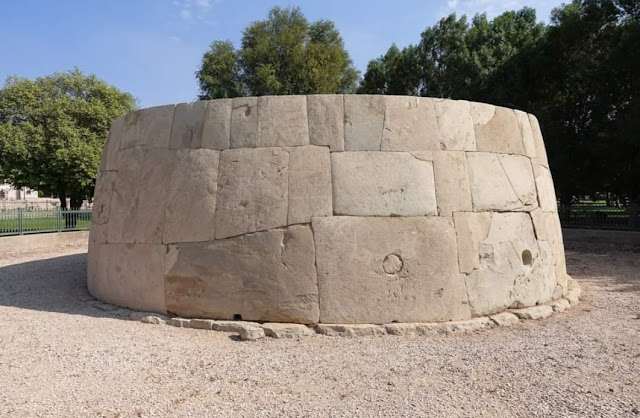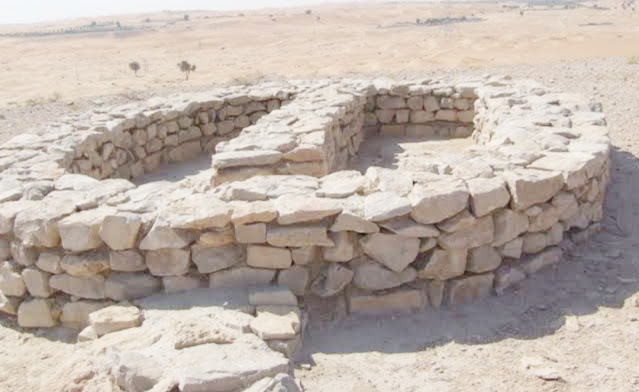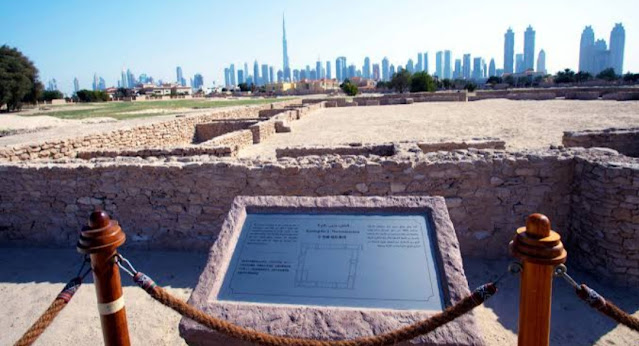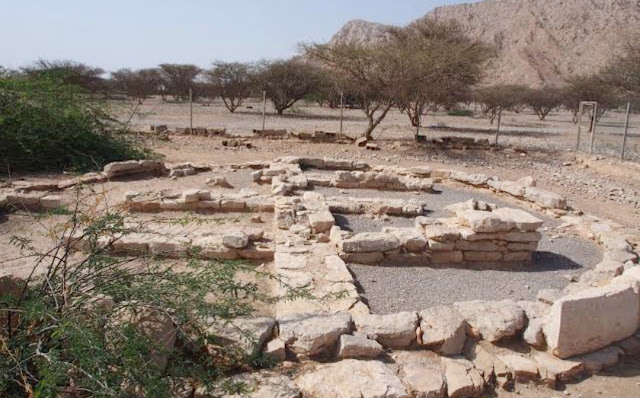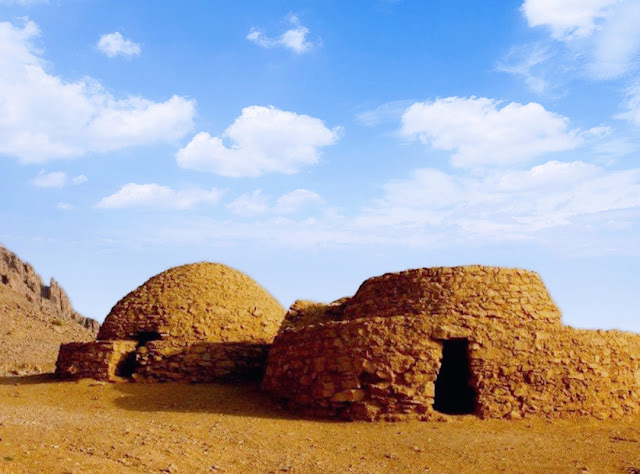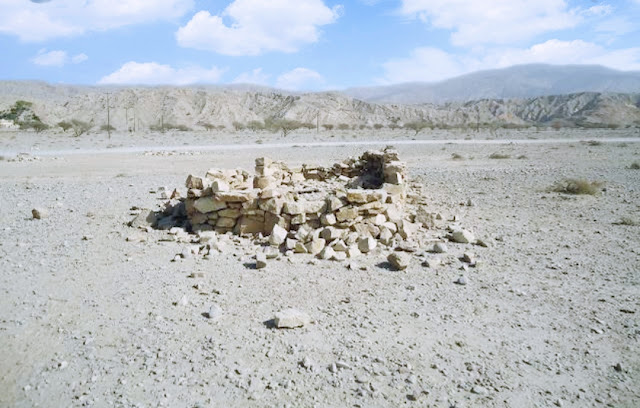An archaeological site is any place where there are physical remains of past human activities. There are many types of archaeological sites. Prehistoric archaeological sites are those without a written record. They may include villages or cities, stone quarries, rock art, ancient cemeteries, campsites, and megalithic stone monuments.
The UAE also has a number of traditional archeological sites, the top 10 of which are listed here.
1. Al Thuqeibah
Al Thuqeibah is an Iron Age archeological site located near the town of Al Madam in Sharjah, United Arab Emirates (UAE). Thuqeibah has been dated from the Iron Age II and III periods (1,100-400 BC). A settlement consisting of several houses and a well, which is believed to date back to the Iron Age II, is associated with the nearby Iron Age falaj system.
Analysis of the finds from Thuqeibah shows that although considerable numbers of Iron Age arrows were found on the site, its inhabitants kept livestock. The combination of agriculture and hunting is in line with the social transformation that took place throughout the Wadi Suq era. In addition, bronze blades, needles, awls and pins were found, pointing to a wide range of economic activity.
The finds at Thuqeibah , located at the natural crossing of the Hajar Mountains, indicate that the inhabitants ate an unusual amount of sea fish (80 km from the nearest sea) so the village was integrated into the vast Iron Age economy. An unusually large number of storage jars were found at the site.
An unusual find, House H4, is located approximately 200 meters from the center of Tukheba, and has a number of well-built fireplaces that are unrelated to the main structure and show no evidence of food processing or other related crafts. The site was originally excavated by teams from the Autonomous University of Madrid in the mid-1990s.
2. Hili Archeological Park
Hili Archaeological Park is the location of a Bronze Age site in Al Ain, Emirate of Abu Dhabi,United Arab Emirates. It is the largest Bronze Age site in the UAE and dates from the 3rd millennium BCE. The Hili Grand Tomb is a tower measuring 12 m (39 ft) in diameter that has been reconstructed. The tombs belong to the Umm al-Nar culture. In May 2019, the Abu Dhabi Department of Culture & Tourism reported that fingerprints about 3000 years old were found at Hili II. They apparently belonged to craftsmen who constructed a wall at the site.
Other remains include settlements, tombs, and a falaj dating from the Iron Age. Findings from the site can be found at the Al Ain National Museum in central Al Ain. Some of the site is located outside the park in a protected area.
3. Bidaa Bint Saud
Bida Bint Saud is one of the many important archaeological sites found in the UAE. The site is situated 15 kilometres from Al Ain City. Excavations have unearthed several stone tombs from the site, some of which are 5,000 years old - dating to the Bronze and Iron Age. Other notable discoveries include the 3,000-year-old Falaj Irrigation System. It is a listed UN World Heritage Site. Finds from the site are displayed at Al Ain National Museum.
Located approximately north of Al Ain, the site is thought to be a stopping point on the long established caravan route from the settlements in Al Ain to the Northern Emirates. The rocky site of Gorn Bin Saud is about 40 meters (130 feet) high and is covered with burial remains.
Access to the area is restricted as part of conservation activities. However, visitors can always visit the Al Ain National Museum to see the excavated artifacts.
4. Jumeirah Archaeological Site
The Jumeirah Archaeological Site is located in the Jumeirah District of Dubai, United Arab Emirates, dating back to the ninth century AD during the Abbasid period. Archaeological excavations at the site, which was discovered in 1969, demonstrate that the area was inhabited as far back as the Abbasid era, approximately in the 10th century CE.
It was first excavated in 1969 with different ancient items including architectural and decorative findings, ranging from a mosque, caravanserai, and residential houses to glazed pottery jars and plateware, bronze coins, glass and stone artefacts.It is owned and managed by Dubai Culture & Arts Authority.
Measuring about 80,000 m2 (860,000 sq ft), the site lay along a caravan route linking India and China to Oman and Iraq.
5. Baynunah Fossil Site
Baynunah is a Paleontological formation located in the western part of the Emirate of Abu Dhabi in the United Arab Emirates. This is during the high period of the Cenozoic period, the Miocene period.TheBaynunah Fossil Site is famed for the remains of an ancient 6,000-year-old wild camel hunt and chronicle a time long before the proverbial ships of the desert were domesticated. This site provides insight into hunting practices of the Neolithic people who lived in the Al Dhafra Region of western Abu Dhabi.
6. Hatta Heritage Village
Hatta Heritage Village is a reconstruction of a traditional mountain village located in Hatta, in the Hajar Mountains, Dubai, United Arab Emirates. Home to centuries-old citadels, towers, forts and the remains of a former village, the historic location is a site that history-buffs will certainly appreciate. The village consists of 30 buildings, many of which have interior furnishings typical of the UAE in the period prior to development in the 1960 onwards.
The village was opened to the public in February 2001 after extensive renovation, and is currently owned and managed by the Dubai Culture & Arts Authority.
7. The Necropolis of Shimal
Necropolis of Shimal is the name of a settlement in Ras Al Khaimah, United Arab Emirates. It is also the location of an important archaeological site dating back to the Umm Al Nar culture (2,500-2,000 BC). Tombs excavated and surveyed at Shimal include both the round Umm Al Nar type and the barrow tombs typical of the 'Wadi Suq' era.
The burial grounds at Shimal consist of at least 250 graves, some of which have been found to encompass over 300 burials. Many of the tombs were re-used. The nearby site of Seih Al Harf mirrors many of the finds at Shimal.
8. Jebel Hafeet Tombs
Situated in the foothills of the imposing Jebel Hafeet mountain, Al Ain's largest peak, you will find more than 500 ancient tombs, known as the Jebel Hafeet Tombs.The 5,000-year-old Jebel Hafeet tombs mark the beginning of the Bronze Age in the UAE. Excavations by Danish archaeologists in 1959 found evidence for ceramic vessels and copper artefacts in these tombs. These artefacts indicate the importance of maritime trade across the Arabian Gulf. The tombs are single-chamber tombs and are made of local unworked or roughly cut stones. These differ from later Umm an-Nar tombs in the area.
At a distance of nine kilometers at the foot of Mount Jebel Hafit, visitors can explore the magnificent natural surroundings of the family-friendly park on a mountain bike, horse or camel and discover fascinating archeological and historical relics that tell these unique stories. Ancient settlement of the area.
Jebel Hafit Desert Park not only preserves the area’s rich history but also its unique biodiversity, encouraging visitors to experience this dynamic landscape up close and understand how it has changed over millions of years. In 2011, UNESCO recognised the Jebel Hafit Desert Park area as being a vital component of the World Heritage Site of Al Ain, the UAE’s first World Heritage Site.
You’ll be able to see the incredible Jebel Hafit Tombs on a guided hike through the area, organised by the Jebel Hafit Desert Park.
9. Sieh Al Herf
Seih Al Harf is an archaeological site in Northern Ras Al Khaimah, in the United Arab Emirates, dating back to the Wadi Suq period (2000–1300 BCE). The site was first discovered in the late 1980s by British archaeologists and was put under a preservation order by the ruler of Ras Al Khaimah in 2004.
Although the site was seen to be threatened by the development of the northern extension of the arterial Emirates Road (E611), with proposals tabled to amend the road development to avoid damage to the site, the road project went ahead.
Seih Al Harf was excavated by a team from the University of Durham, led by Derek Kennet, in the spring of 2013. The site comprises a series of 50 burial sites, of which two were directly threatened by the road development, an 18-metre horseshoe shaped and a W-shaped tomb. Both were collective graves. Ten other excavated features were also impacted by the road development.
The 2013 dig excavated three monumental graves, six smaller collective tombs and a number of smaller burials. The three monumental tombs were all stone-built, corbelled structures and stand as some of the largest tombs from the Wadi Suq period found in Ras Al Khaimah.
Included in some 10,000 artifacts[2] removed from Seih Al Harf for research, the Durham team found a large variety of spearheads, arrowheads, razors, jewellery (including carnelian beads), blades, soft-stone and pottery vessels. One find included the skeleton of a woman found still wearing her bangles on her forearm.
10. Wadi al Helo
The Wadi al Helo is a notable archaeological site in the UAE. Home to a historical site and unearthed Islamic watchtower. Nestled between the Hajar mountains, the wadi is a protected area for endangered birds, reptiles, rodents and freshwater fish. Also known as “Sweet Valley”, the area has been declared a protected area due to an abundance of wild flora and fauna.
The most famous route is the easy way up a hill, where an old fort offers a 360 degree view of the UAE mountains. If you’re up for more trekking, follow the well-worn animal tracks deeper into the wadi. You are likely to meet in the desert, flowers, wildlife such as badgers in the way of the UAE's National Animal Arabian oryx.
If you are traveling with family, consider one of the guided hiking tours. Kids will especially enjoy exploring Vadi. Wadi al Helena as a destination, so the Guides can be able to provide integral care for your family

